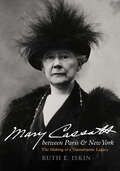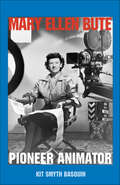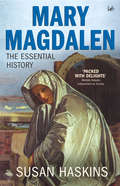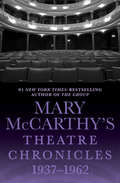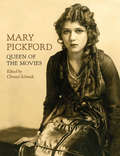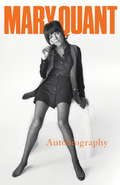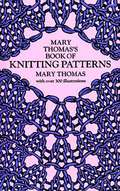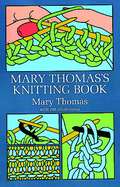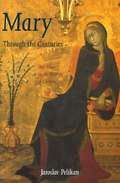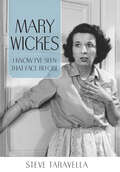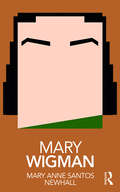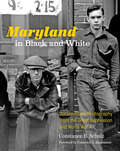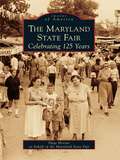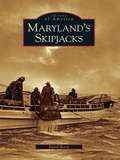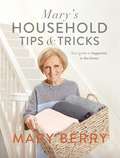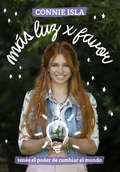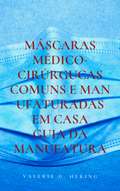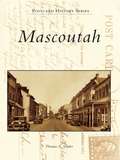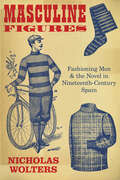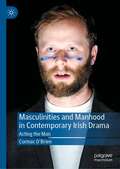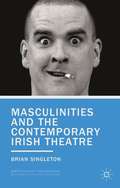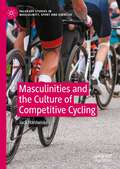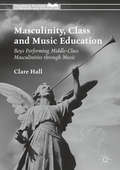- Table View
- List View
Mary Cassatt between Paris and New York: The Making of a Transatlantic Legacy
by Ruth E. IskinThe first comprehensive study of Cassatt’s life, work, and legacy through the prism of a transatlantic framework. This book re-envisions Mary Cassatt in the context of her transatlantic network, friendships, exhibitions, politics, and legacy. Rather than defining her as either an American artist or a French impressionist, author Ruth E. Iskin argues that we can best understand Cassatt through the complexity of her multiple identifications as an American patriot, a committed French impressionist, and a suffragist. Contextualizing Cassatt’s feminist outlook within the intense pro- and anti-suffrage debates in the United States, Iskin shows how these impacted her artistic representations of motherhood, fatherhood, and older women. Mary Cassatt between Paris and New York also argues for the historical importance of her work as an advisor to American collectors, and demonstrates the role of museums in shaping her legacy, highlighting the combined impact of gender, national, and transnational dynamics.
Mary Ellen Bute: Pioneer Animator
by Kit Smyth BasquinMary Ellen Bute: Pioneer Animator captures the personal and professional life of Mary Ellen Bute (1906–1983) one of the first American filmmakers to create abstract animated films in 1934, also one of the first Americans to use the electronic image of the oscilloscope in films starting in 1949, and the first filmmaker to interpret James Joyce's literature for the screen, Passages from James Joyce's Finnegans Wake, a live-action film for which she won a Cannes Film Festival Prize in 1965. Bute had an eye for talent and selected many creative people who would go on to be famous. She hired Norman McLaren to hand paint on film for the animation of her Spook Sport, 1939, before he left to head the animation department of the Canadian Film Board. She cast the now famous character actor Christopher Walken at age fourteen as the star of her short live-action film, The Boy Who Saw Through, 1958. Also, Bute enlisted Elliot Kaplan to compose the film score of her Finnegans Wake before he moved on to compose music for TV's Fantasy Island and Ironside. This biography drawn from interviews with Bute's family, friends, and colleagues, presents the personal and professional life of the filmmaker and her behind-the-scenes process of making animated and live action films.
Mary Magdalen: Truth and Myth
by Susan HaskinsA dramatic, thought-provoking portrait of one of the most compelling figures in early Christianity which explores two thousand years of history, art, and literature to provide a close-up look at Mary Magdalen and her significance in religious and cultural thought.
Mary McCarthy's Theatre Chronicles, 1937–1962: Mary Mccarthy's Theatre Chronicles, 1937-1962 And On The Contrary
by Mary McCarthyThe American theatre comes alive in Mary McCarthy&’s provocative anthology of essaysHer literary writings and dramatic criticism have appeared in the New Yorker and the New York Review of Books. Mary McCarthy&’s Theatre Chronicles gathers together a wide-ranging collection featuring a cast of playwrights, actors, and directors that reads like a &“who&’s who&” of American theatre. With chapters ranging from &“The Unimportance of Being Oscar&” to &“Odets Deplored,&” this lively and witty volume opens a revealing window onto every aspect of theatre. McCarthy brings singular productions of the world&’s most famous plays to vivid dramatic life while dissecting literary giants like Tennessee Williams and Arthur Miller. She offers her controversial opinion on everything from the American school of realism as epitomized by Brando to what creates a great actress to how a badly written play can still make for good theatre.With passages on theatre figures from Shakespeare to Shaw to Ibsen and O&’Neill, this is a must-have for theatre lovers and armchair critics everywhere.This ebook features an illustrated biography of Mary McCarthy including rare images from the author&’s estate.
Mary Pickford: Queen of the Movies
by Christel Schmidt&“Explains Pickford&’s roles as not only a talented actress, but also as a philanthropist and industry leader who managed to end up her own producer.&” —Time Out In the early days of cinema, when actors were unbilled and unmentioned in credits, audiences immediately noticed Mary Pickford. Moviegoers everywhere were riveted by her magnetic talent and appeal as she rose to become cinema&’s first great star. In this engaging collection, co-published with the Library of Congress, an eminent group of film historians sheds new light on this icon&’s incredible life and legacy. Pickford emerges from the pages in vivid detail, revealed as a gifted actress, a philanthropist, and a savvy industry leader who fought for creative control of her films and ultimately became her own producer. With extensive photos and illustrations, this book paints a fascinating portrait of a key figure in American cinematic history. Includes over 200 photos, illustrations, and stills from the collections of the Library of Congress and Academy of Motion Picture Arts and Sciences
Mary Quant: My Autobiography
by Mary QuantMary Quant defined the 60s as a renowned fashion designer and all-round style icon, most famous for inventing the miniskirt and hot pants. Not afraid of novelty or experimentation, she showed a generation of women how to dress to please themselves. Quant's career was fulsome and varied - from opening up a clothes shop on the King's Road called Bazaar, designing the interior of the Mini (including her signature daisy), to her vast cosmetics company, Mary Quant Limited, she has widespread appeal to generations of women. In her autobiography, Mary combines the inspirational story of a stellar career with the touching personal story of her life with the man she loved, Alexander Plunkett-Green and her role of mother to their son, Orlando. Mary Quant gives us a glimpse of the real women behind the icon.
Mary Quant: My Autobiography
by Mary QuantMary Quant defined the 60s as a renowned fashion designer and all-round style icon, most famous for inventing the miniskirt and hot pants. Not afraid of novelty or experimentation, she showed a generation of women how to dress to please themselves. Quant's career was fulsome and varied - from opening up a clothes shop on the King's Road called Bazaar, designing the interior of the Mini (including her signature daisy), to her vast cosmetics company, Mary Quant Limited, she has widespread appeal to generations of women. In her autobiography, Mary combines the inspirational story of a stellar career with the touching personal story of her life with the man she loved, Alexander Plunkett-Green and her role of mother to their son, Orlando. Mary Quant gives us a glimpse of the real women behind the icon.
Mary Thomas's Book of Knitting Patterns (Dover Knitting, Crochet, Tatting, Lace)
by Mary ThomasThis book contains the fruits of centuries of experience and invention in knitting and is quite possibly the best single manual of knitting patterns ever written. Turning its pages, you will see the patterns grow from simple to more elaborate. You will find this to be the best arrangement for instructional purposes as well as a demonstrations of the orderly and scientific methods on which knitting patterns are based. You will be astonished at the great beauty and variety of these patterns, and you will come to realize the potential of knitting, in practiced hands, as one of the finest of crafts.The author begins with basics, with the distinction between knit and purl sides of the fabric and the use of simple black-and-white charts to present patterns. She then introduces a new motif or design in each chapter. Charts, diagrams, and photographs are used liberally along with the text to illustrate each pattern and steps in the creation of each, with special symbols to indicate critical points, so that you can guard against going astray. The patterns range from cross and cross-over motifs through slip-stitch patterns, eyelet patterns, faggot and lace faggot stitch, bias fabrics, lace knitting, embossed motifs and patterns, medallion knitting, picot point knitting, and filet lace. Concluding chapters are devoted to seamless garments and accessories, modern garments, and ornamental uses of increasing and decreasing. There are lists of French and German knitting terms and an index of textures.Special attention is given throughout to explaining the how and why of each pattern, and the properties of each in terms of horizontal and vertical stretching so that selection of patterns can be made practically as well as aesthetically. The beginner will find this book an excellent guide and instruction manual, and the experienced knitter will find it an almost inexhaustible encyclopedia of patterns, methods, and suggestions.
Mary Thomas's Knitting Book
by Mary ThomasThere is a knitting book as dependable as your own private instructor, as complete, as explicit, and equally as helpful . . . Mary Thomas's Knitting Book. It's a veritable encyclopedia of knitting, clearly and definitively explaining and illustrating every method, operation and stitch, and a good number of the patterns you are ever likely to need or use. After an engaging history of the craft and its implements, Miss Thomas carefully lays the foundation of knitting in the opening chapters ― how to hold needles, wind yarn, gauge stitches, control tension, etc. ― and builds gradually upon it in the following sections. These explain in lucid progression every operation in common knitting, from basic knit stitch and purl, casting on and casting off, shaping by decreases and increases to turning, triangular shapes and mitres, and knitting on the diagonal or bias. For the reader who has mastered these fundamental procedures, Miss Thomas devotes the remainder of the book to fancy knitting stitches and techniques, including color knitting by stranding and weaving; pattern weaving; knitting woven, by frame with its complement of stitches (plain, raised, rib, etc.), looped, beaded, embroidered by chart, using cross stitch, honeycomb, etc.; and making patterns for garments and working out their details (armholes, belts, buttonholes, collars, hems, necklines, pockets et al). To put what the reader learns into practice, she offers instructions and patterns for making various Shetland shawls, gloves, and socks. More than 250 technique diagrams clearly illustrate every operation and pattern as to position of hands, yarn, and needle, so the knitter will have no trouble in following along. For all knitters, whether beginner or adept, a chapter of helpful knitting hints on blocking, picking up dropped stitches, lengthening, knitting up, mending, taking-back (correcting), etc. completes these invaluable and personalized lessons.Unabridged republication of original (1938) edition.
Mary Through the Centuries: Her Place in the History of Culture
by Jaroslav PelikanExamines all of Christian history & culture to create the most complete portrait of the Virgin Mary every written. Pelikan assesses the ways people throughout time & place have depicted, venerated, & been inspired by Mary.
Mary Wickes: I Know I've Seen That Face Before (Hollywood Legends Series)
by Steve TaravellaMoviegoers know her as the housekeeper in White Christmas, the nurse in Now, Voyager, and the crotchety choir director in Sister Act. This book, filled with never-published behind-the-scenes stories from Broadway and Hollywood, chronicles the life of a complicated woman who brought an assortment of unforgettable nurses, nuns, and housekeepers to life on screen and stage. Wickes (1910–1995) was part of some of the most significant moments in film, television, theatre, and radio history. On that frightening night in 1938 when Orson Welles recorded his earth-shattering “War of the Worlds” radio broadcast, Wickes was waiting on another soundstage for him for a rehearsal of Danton's Death, oblivious to the havoc taking place outside. When silent film star Gloria Swanson decided to host a live talk show on this new thing called television, Wickes was one of her first guests. When Lucille Ball made one of her first TV appearances, Wickes appeared with her—and became Lucy's closest friend for more than thirty years. Wickes was the original Mary Poppins, long before an umbrella carried Julie Andrews across the rooftops of London. And when Disney began creating 101 Dalmatians, Wickes was asked to pose for animators trying to capture the evil of Cruella De Vil. The pinched-face actress who cracked wise by day became a confidante to some of the day's biggest stars by night, including Bette Davis and Doris Day. Bolstered by interviews with almost three hundred people, and by private correspondence from Ball, Davis, Day, and others, Mary Wickes: I Know I've Seen That Face Before includes scores of never-before-shared anecdotes about Hollywood and Broadway. In the process, it introduces readers to a complex woman who sustained a remarkable career for sixty years.
Mary Wigman: Modernity And Mary Wigman, 1886--1973 (Routledge Performance Practitioners)
by Mary Anne Santos NewhallThis book considers dancer, teacher, and choreographer Mary Wigman, a leading innovator in Expressionist dance whose radical explorations of movement and dance theory are credited with expanding the scope of dance as a theatrical art. Now reissued, this book combines: a full account of Wigman’s life and work an analysis of her key ideas detailed discussion of her aesthetic theories, including the use of space as an "invisible partner" and the transcendent nature of performance a commentary on her key works, including Hexentanz and The Seven Dances of Life an extensive collection of practical exercises designed to provide an understanding of Wigman’s choreographic principles and her uniquely immersive approach to dance. As a first step towards critical understanding, and as an initial exploration before going on to further, primary research, Routledge Performance Practitioners are unbeatable value for today’s student.
Maryland in Black and White: Documentary Photography from the Great Depression and World War II
by Constance B. SchulzCompelling photographs of people and places throughout Maryland during one of the nation's most anxious decades.Between 1935 and 1943, the United States government commissioned forty-four photographers to capture American faces, along with living and working conditions, across the country. Nearly 180,000 photographs were taken—4,000 in Maryland—and they are now preserved in the Prints and Photographs Division of the Library of Congress. Constance B. Schulz presents a selection of these images in Maryland in Black and White. Maryland in the 1930s and early ‘40s truly represented a microcosm of America, a middle ground where beach and mountain, north and south, urban and rural, black and white, farmer and businessman, rich and poor, young and old met. This period also witnessed a turning point in the state’s history. The pace and nature of change varied from region to region, but even in areas that seemed most resistant to it—the Chesapeake Bay, where oyster tongers harvested their catch using methods unchanged for centuries, or the mountains and streams of Garrett County, where the seasons timelessly repeated themselves—the momentum toward a modern economy, influenced if not dominated by urban and national concerns, had significant impact.Within these pages, the farms and coal fields of 1930s and '40s Western Maryland, the tobacco fields of Southern Maryland, watermen in wooden boats along the Eastern Shore, and smiling couples dancing at a wartime senior prom come back to life. These photographs reveal places we know but scarcely recognize and give us another look at the people of "the greatest generation."
Maryland State Fair: Celebrating 125 Years, The (Images of America)
by Maryland State Fair Paige HorineAccording to Gov. Robert L. Ehrich Jr., "[The Maryland StateFair] is an annual opportunity as Marylanders to come together to celebrate the history, tradition, and charm of our State during the best days of summer." The Maryland State Fair has continued the tradition of delighting Marylanders near and far since the late 1800s. Hosting governors to 4-H'ers, farm animals to farm hands, home arts to computer arts, the fair has always promised something for everyone. Fair favorites such as the sweet, intoxicating scent of warm cotton candy and the heartthundering excitement and majesty of Thoroughbred racing were as much a part of the Maryland State Fair 125 years ago as they are today. Readers can find it all in The Maryland State Fair: Celebrating 125 Years.
Maryland's Skipjacks
by David A. BerryChesapeake is an Algonquian word meaning "great shellfish bay," and for decades, the oyster was the undisputed king of Chesapeake Bay shellfish. Early settlers reported them to be as large as dinner plates, and the reefs or rocks in which they livedwere large enough to be hazards to navigation. In 1884, fifteen million bushels of oysters were harvested and shipped around the world. The skipjack was the perfect vessel for sailing into the Chesapeake Bay's shallow waters and dredging for oysters, and each winter, hundreds of these wooden craft set out across the bay's cold waters. The oyster population of the 21st century is a fraction of what it once was, and the skipjacks have disappeared along with them. No longer economically viable, the boats have been left to rot in the marshes along the bay. Only 25 boats are still operational, and fewer than five still dredge.
Mary's Household Tips and Tricks: Your Guide to Happiness in the Home
by Mary BerryGet organised in 2022 with Mary Berry's essential household tips that will make home your true happy place'Practical AND beautiful' Graham Norton, BBC Radio 2________'This book is a collection of skills I've learned for running a home. Gleaned from years of practical experience, along with all the hints that friends and family have imparted to me, I hope it will be a helping hand' Mary BerryJoin national treasure Mary Berry in her comprehensive, beautifully illustrated guide that shares her greatest tips on how to care for your home. Inside you'll find . . . - KITCHEN KNOW-HOW: Love the heart of your home with freezer tips and how to organise your food- CLEANING & CONFIGURING YOUR HOME: Create cleaning products from store cupboard items- LAUNDRY & WARDROBE WISDOM: Banish moths from your home for good, remove stains from every kind of fabric- GARDENING & FLOWERS: Bring greenery into your home even without a garden, create beautiful flower arrangementsEasy to use, practical and gorgeously illustrated, Mary's Household Tips & Tricks covers everything from Mary's golden rules for baking to her favourite flowers for each season, from how to polish silver to whether tea should be poured before or after milk.With secrets for accomplishing the most challenging home-keeping tasks with ease, Mary's wonderfully simple book will help turn any house into a home.'The Queen of British baking has whipped up a recipe for home happiness' Independent'A domestic goddess' Daily Telegraph
Más luz x favor: Tenés el poder de cambiar el mundo
by Connie IslaUna de las influencers veganas argentinas de mayor crecimiento cuenta su viaje profundamente personal, un recorrido que va desde su temprana pasión por distintas formas de expresión artística hasta su experiencia de autodescubrimiento y su entrega completa a la causa feminista y a la lucha por un estilo de vida sustentable. Hola. Soy Connie, y quiero agradecerte que tengas mi libro en tus manos. Vengo a proponerte que me acompañes en un viaje, un viaje personal y revelador. Un recorrido por algunas cosas que hice en mi vida, gracias a las cuales me caí, me levanté, reflexioné, aprendí, cambié y entendí que está en nuestras manos hacer de este un mundo mejor. Y que para eso primero es necesario estar dispuestos a conocer, a cuestionarnos y saber algunas cosas que a veces preferiríamos no saber: de dónde viene eso que comemos, quién hizo las prendas con las que nos vestimos, cuánto tarda en degradarse esa botella de plástico que usamos y desechamos, y por qué a veces miramos para otro lado cuando se nos presenta esa verdad incómoda. Espero que acá encuentres no sólo respuestas, sino también preguntas, así como también herramientas para ayudarte a transitar este camino largo pero poderoso. Porque la información es poder, y tenemos el poder de cambiar el mundo. Sí, vos, una sola persona, aunque te cueste creerlo. Cada pequeña acción cuenta. Necesitamos acercarnos un poco más. Tener más compasión. Más conciencia. Más empatía. Más amor. Más luz, por favor.
Máscaras Médico-Cirúrgucas Comuns e Manufaturadas em Casa: Guia da Manufatura
by Valerie D. HeringSurgiu uma necessidade imperial para todos - amigos, familiares, amigos, nós próprios, a comunidade em geral - de nos protegermos através de práticas de responsabilidade cívica e de prevenção individual e coletiva. O uso de uma máscara facial é uma das formas mais significativas de alcançar esse objetivo, muito em particular depois do mundo inteiro ter sido afetado pela atual pandemia infecciosa viral. Estamos, atualmente, a experienciar os efeitos devastadores provocados por um surto epidémico que resultou num número considerável de casos infetados e tem conduzido o mundo inteiro a uma escassez de materiais vitais no combate a esta pandemia, logo a adesão em massa à produção de máscaras médico-cirúrgicas tornou-se uma necessidade acrescida. A produção de máscaras faciais não significa somente dar um passo importante em direção a um fururo promissor. Traduz-se num ato refletido em prol da proteção de toda a humanidade contra vírus e bactérias nocivas à saúde populacional. Esta não é uma missão impossível, é uma prevenção que poderá assegurar através da produção de máscaras eficazes, ao recorrer a um processo que pode ser realizado em apenas alguns minutos. Este livro faculta determinados detalhes, extremamente valiosos, relativamente à manufatura das máscaras cirúrgicas e fornece instruções simples, com ilustrações, para que qualquer pessoa possa aprender a fazer a sua própria máscara em casa. Salienta, ainda, dados importantes acerca dos principais surtos virais transmitidos por via respiratória, respetivas formas de prevenção e outros pontos relevantes acerca do uso correto e adequado das máscaras faciais médico-cirúrgicas, com ou sem acessório respirador. As máscaras cirúrgicas comuns minimizam o risco de contágio contra infeções virais e bacteriológicas transmitidas por via respiratória. Note porém que o uso das máscaras faciais caseiras não protege contra infecções respiratórias vi
Mascoutah (Postcard History)
by Thomas S. SnyderGerman emigrants established Mascoutah in 1837, naming it after the Mascouten Indians. Despite being located in an area filled with swamps, snakes, and disease, the village prospered, owing primarily to a flour mill that drew farmers into town. This brought customers to merchants and tradesmen. By the 1850s, Mascoutah was thriving and had established itself as the social and cultural center of the surrounding area. By 1900, it was the third-largest town in St. Clair County and one of the most progressive. World War I, the establishment of Scott Air Force Base, Prohibition, and the Great Depression soon altered the course of Mascoutah's history, but the town retained its resiliency. For over 170 years, Mascoutah has grown and adapted to meet a changing world, retaining its small-town flair and pride in its German heritage.
Masculine Figures: Fashioning Men and the Novel in Nineteenth-Century Spain
by Nicholas WoltersBased on years of archival research in Madrid and Barcelona, this interdisciplinary study offers a fresh approach to understanding how men visualized themselves and their place in a nation that struggled to modernize after nearly a century of civil war, colonial entanglement, and imperial loss. Masculine Figures is the first study to provide a comprehensive overview of competing models of masculinity in nineteenth-century Spain, and it is particularly novel in its treatment of Catalan texts and previously unstudied evidence (e.g., department store catalogs, commercial advertisements, fashion plates, and men&’s tailoring journals). Fictional masculinity performs a symbolic role in representing and negotiating the contradictions male novelists often encountered in their attempts to professionalize not only as writers, but also as businessmen, professors, lawyers, and politicians. Through specific and recurring figures like the student, the priest, the businessman, and the heir, male novelists portray and represent an increasingly middle-class world at odds with the values and virtues it inherited from an imperial Spanish past, and those it imported from more industrialized nations like England and France. The visual culture of the time and place marks the material turn in middle-class masculinity and sets the stage for discussions of race and sexuality.
Masculinities and Manhood in Contemporary Irish Drama: Acting the Man
by Cormac O'BrienThis book charts the journey, in terms of both stasis and change, that masculinities and manhood have made in Irish drama, and by extension in the broader culture and society, from the 1960s to the present. Examining a diverse corpus of drama and theatre events, both mainstream and on the fringe, this study critically elaborates a seismic shift in Irish masculinities. This book argues, then, that Irish manhood has shifted from embodying and enacting post-colonial concerns of nationalism and national identity, to performing models of masculinity that are driven and moulded by the political and cultural practices of neoliberal capitalism. Masculinities and Manhood in Contemporary Irish Drama charts this shift through chapters on performing masculinity in plays set in both the Irish Republic and Northern Ireland, and through several chapters that focus on Women’s and Queer drama. It thus takes its readers on a journey: a journey that begins with an overtly patriarchal, nationalist manhood that often made direct comment on the state of the nation, and ultimately arrives at several arguably regressive forms of globalised masculinity, which are couched in misaligned notions of individualism and free-choice and that frequently perceive themselves as being in crisis.
Masculinities and Representation: The Eroticized Male in Early Modern Italy and England
by Konrad EisenbichlerIn studies on premodern masculinities that have enriched scholarship in recent years, relatively little attention has been paid to the eroticizing of the male body. Masculinities and Representation seeks to fill this lacuna, illustrating how gender construction served to affirm but also diversify premodern masculinity. In so doing, this collection details how, as a social construct, masculinity was not a single concept, but a dynamic and intricate notion. Focusing on the premodern period, Masculinities and Representation reveals how heteronormative masculinity was affirmed, but also how it was challenged when the male body was eroticized in art, literature, and devotion, or when “masculine” norms were transgressed by the assumption of “feminine” behaviours. Ultimately, the book demonstrates how masculinity itself could be transgressive in its focus of affection or in its inherent ambiguities.
Masculinities and the Contemporary Irish Theatre
by Brian SingletonIrish theatre and its histories appear to be dominated by men and their actions. This book's socially and culturally contextualized analysis of performance over the last two decades, however reveals masculinities that are anything but hegemonic, played out in theatres and other arenas of performance all over Ireland.
Masculinities and the Culture of Competitive Cycling (Palgrave Studies in Masculinity, Sport and Exercise)
by Jack HardwickeDrawing on extensive ethnographic, qualitative and quantitative research, this monograph provides a novel account of masculinities in an individual sport: competitive road cycling. Chapters present varied analyses on male cyclists’ relationship with masculinity, the culture of competitive road cycling, cyclists’ attitudes toward injury management, sexual minority and women’s experiences in the sport, and autoethnographic accounts of the author’s own experiences of being involved in the sport for over ten years. The author also examines how masculinity impacts male cyclists’ attitudes towards competition, risk taking and doping practices. This book will be of interest to scholars and researchers in sports sociology, gender studies, and masculinity studies.
Masculinity, Class and Music Education: Boys Performing Middle-Class Masculinities through Music (Palgrave Studies in Gender and Education)
by Clare HallThis book offers a provocative sociological examination of masculinity, class and music education within the context of a unique and fascinating culture: the classical musical world of choirboys. The myriad cultural meanings embodied in the ‘boy voice’ are unravelled through compelling musical narratives of young choirboys, their mothers, and their teachers. The book investigates how boys negotiate dominant gender-class discourses and the various pedagogies involved in producing middle-class masculinities during primary school and early years contexts. Drawing on the theoretical resources of Bourdieu to develop the concept of ‘musical habitus’, the continued symbolic distinction of the choirboy is analysed in order to better understand how culture is simultaneously reproduced and evolving through music. This interdisciplinary work at the juncture of pedagogy and culture will appeal to social science researchers, educators and arts practitioners interested in the sociocultural dynamics of music.
